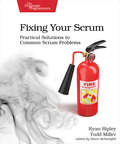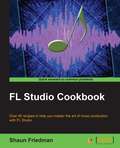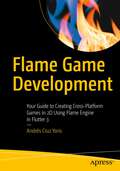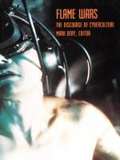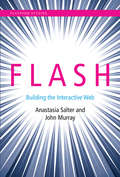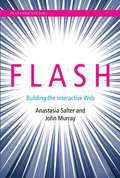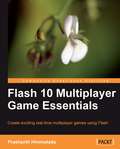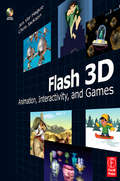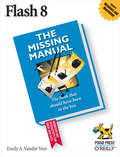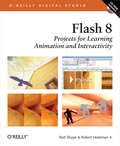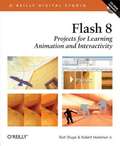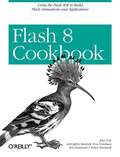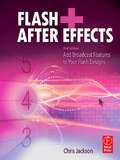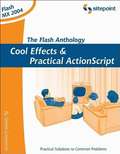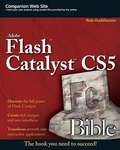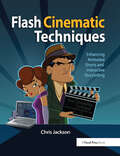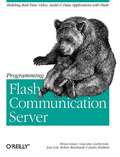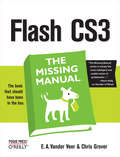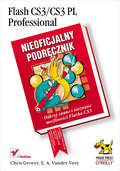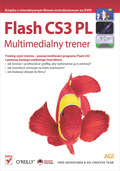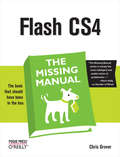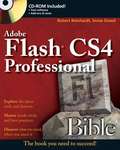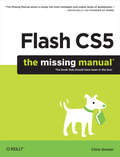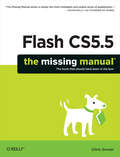- Table View
- List View
Fixing Your Scrum: Practical Solutions to Common Scrum Problems
by Ryan Ripley Todd MillerA Scrum Master's work is never done. The Development team needs your support, the Product Owner is often lost in the complexities of agile product management, and your managers and stakeholders need to know what will be done, by when, and for how much. Learn how experienced Scrum Masters balance the demands of these three levels of servant leadership while removing organizational impediments and helping Scrum Teams deliver real world value. Discover how to visualize your work, resolve impediments, and empower your teams to self-organize and deliver using the Scrum Values, Agile Principles, and advanced coaching and facilitation techniques. A Scrum Master needs to know when their team is in trouble and understand how to help them get back on the path to delivery. Become a better Scrum master so you can find the problems holding your teams back. Has your Daily Scrum turned in to a meeting? Does your team struggle with creating user stories? Are stakeholders disengaged during Sprint Review? These issues are common. Learn to use empiricism as your guide and help your teams create great products. Scrum is so much more than a checklist of practices to follow, yet that's exactly how many organizations practice it. Bring life back to your Scrum events by using advanced facilitation techniques to leverage the full intelligence of your team. Improve your retrospectives with new formats and exercises. Ask powerful questions that spark introspection and improvement. Get support and buy-in from management. Use Scrum as a competitive advantage for your organization. Create a definition of done that improves quality and fix failing sprints. Take the next step on your journey as a Scrum master. Transform your Scrum practices to help your teams enjoy their work again as they deliver high quality products that bring value to the world. What You Need: A moderate level of experience using the Scrum Framework.
FL Studio Cookbook
by Shaun FriedmanThis book is built on recipes written in an easy-to-follow manner accompanied by diagrams and crucial insights and knowledge on what they mean in the real world. This book is ideal for musicians and producers who want to take their music creation skills to the next level, learn tips and tricks, and understand the key elements and nuances in building inspirational music. It's good to have some knowledge about music production, but if you have creativity and a good pair of ears, you are already ahead of the curve and well on your way.
Flame Game Development: Your Guide to Creating Cross-Platform Games in 2D Using Flame Engine in Flutter 3
by Andrés Cruz YorisReimagine your development process and create, test, and deploy your mobile, web, desktop, and embedded apps from a single codebase. This book shows you how to leverage Flame, the modular Flutter game engine, to build cross-platform 2D games. With Flutter, you can create all kinds of apps by making subtle changes to projects at the code level. Guided by a practical project-based approach, you'll begin by downloading and installing the game engine. You'll then move on to creating widgets in Flutter and components within our game, such as player, enemy, background, consumables, etc. The book also shows you how to add sprites, render images, setup animation, and much more. Flame Game Development is perfect for the novice eager to gain hands-on knowledge of this exciting game engine's library to create a simple 2D game. What You'll LearnApply Flutter coding skills to game developmentDevelop games that can be played on all platformsCreate your first 2D game using FlameWho This Book Is ForBeginners who want to learn how to develop games on Flame and create their first 2D game with Flutter.
Flame Wars: The Discourse of Cyberculture
by Mark Dery"Flame Wars," the verbal firefights that take place between disembodied combatants on electronic bulletin boards, remind us that our interaction with the world is increasingly mediated by computers. Bit by digital bit we are being "Borged," as devotees of Star Trek: The Next Generation would have it--transformed into cyborgian hybrids of technology and biology through our ever more frequent interaction with machines, or with one another through technological interfaces.The subcultural practices of the "incurably informed," to borrow the cyberpunk novelist Pat Cadigan's coinage, offer a precognitive glimpse of mainstream culture in the near future, when many of us will be part-time residents in virtual communities. Yet, as the essays in this expanded edition of a special issue of the South Atlantic Quarterly confirm, there is more to fringe computer culture than cyberspace. Within these pages, readers will encounter flame warriors; new age mutant ninja hackers; technopagans for whom the computer is an occult engine; and William Gibson's "Agrippa," a short story on software that can only be read once because it gobbles itself up as soon as the last page is reached. Here, too, is Lady El, an African American cleaning woman reincarnated as an all-powerful cyborg; devotees of on-line swinging, or "compu-sex"; the teleoperated weaponry and amok robots of the mechanical performance art group, Survival Research Laboratories; an interview with Samuel Delany, and more.Rallying around Fredric Jameson's call for a cognitive cartography that "seeks to endow the individual subject with some new heightened sense of place in the global system," the contributors to Flame Wars have sketched a corner of that map, an outline for a wiring diagram of a terminally wired world.Contributors. Anne Balsamo, Gareth Branwyn, Scott Bukatman, Pat Cadigan, Gary Chapman, Erik Davis, Manuel De Landa, Mark Dery, Julian Dibbell, Marc Laidlaw, Mark Pauline, Peter Schwenger, Vivian Sobchack, Claudia Springer
Flash: Building the Interactive Web (Platform Studies)
by John Murray Anastasia SalterHow Flash rose and fell as the world's most ubiquitous yet divisive software platform, enabling the development and distribution of a world of creative content.Adobe Flash began as a simple animation tool and grew into a multimedia platform that offered a generation of creators and innovators an astonishing range of opportunities to develop and distribute new kinds of digital content. For the better part of a decade, Flash was the de facto standard for dynamic online media, empowering amateur and professional developers to shape the future of the interactive Web. In this book, Anastasia Salter and John Murray trace the evolution of Flash into one of the engines of participatory culture. Salter and Murray investigate Flash as both a fundamental force that shaped perceptions of the web and a key technology that enabled innovative interactive experiences and new forms of gaming. They examine a series of works that exemplify Flash's role in shaping the experience and expectations of web multimedia. Topics include Flash as a platform for developing animation (and the “Flashimation” aesthetic); its capacities for scripting and interactive design; games and genres enabled by the reconstruction of the browser as a games portal; forms and genres of media art that use Flash; and Flash's stance on openness and standards—including its platform-defining battle over the ability to participate in Apple's own proprietary platforms. Flash's exit from the mobile environment in 2011 led some to declare that Flash was dead. But, as Salter and Murray show, not only does Flash live, but its role as a definitive cross-platform tool continues to influence web experience.
Flash
by Anastasia Salter John MurrayAdobe Flash began as a simple animation tool and grew into a multimedia platform that offered a generation of creators and innovators an astonishing range of opportunities to develop and distribute new kinds of digital content. For the better part of a decade, Flash was the de facto standard for dynamic online media, empowering amateur and professional developers to shape the future of the interactive Web. In this book, Anastasia Salter and John Murray trace the evolution of Flash into one of the engines of participatory culture. Salter and Murray investigate Flash as both a fundamental force that shaped perceptions of the web and a key technology that enabled innovative interactive experiences and new forms of gaming. They examine a series of works that exemplify Flash's role in shaping the experience and expectations of web multimedia. Topics include Flash as a platform for developing animation (and the "Flashimation" aesthetic); its capacities for scripting and interactive design; games and genres enabled by the reconstruction of the browser as a games portal; forms and genres of media art that use Flash; and Flash's stance on openness and standards--including its platform-defining battle over the ability to participate in Apple's own proprietary platforms. Flash's exit from the mobile environment in 2011 led some to declare that Flash was dead. But, as Salter and Murray show, not only does Flash live, but its role as a definitive cross-platform tool continues to influence web experience.
Flash 10 Multiplayer Game Essentials
by Prashanth HirematadaThe book provides all the essentials needed to implement a fully featured multiplayer game in Flash. It begins by dissecting a basic hello-world example providing its code and an insight into each feature that is required. Following the book is easy because of the excellent illustrations and working code samples. Four complete game implementations with increasing complexity are discussed; each example is presented with detailed design, implementation code, and screenshots. This book discusses essentials for beginner to intermediate Flash Developers who have perhaps created a game or two in Flash and want to take the next step, and create something that can be played by two or more players over the internet. This book will appeal to professional and amateur developers with an inclination to build synchronous multiplayer games with Flash. No prior knowledge of networking or server-side programming is required.
Flash 3D: Animation, Interactivity, and Games
by Chris Jackson Jim Ver HaguePush your creative ideas to the next level in content delivery.Use real and simulated 3D space in your Flash games and interactive systems.3D possibilities offer an untapped creative approach to thinking and designing with Flash. Tap into this medium by: * Creating reusable templates to reduce costs and cycle time for project development. * Experimenting with author-provided interactive examples that demonstrate a broad range of Flash applications from website to DVD/CD-ROM delivery. * Practicing the real-world project techniques presented by the authors in full color. * Expanding your horizons with experimental projects.Jim Ver Hague is a professor of Computer Graphics Design at the Rochester Institute of Technology. He has more than 30 years' experience in the field of computer graphics and has lectured, consulted, and conducted workshops internationally in the fields of multimedia, electronic publishing, computer-aided information design, and computer art and sculpture. Chris Jackson is a computer graphics designer and Associate Professor at Rochester Institute of Technology. Chris has an extensive background in graphic design, printing and interactive multimedia. His professional work has received over 25 distinguished national and international awards for online communication.User Level: Intermediate
Flash 8: The Missing Manual
by E. A. Vander VeerMacromedia's Flash 8 is the world's premier program for adding animation to websites. And with the latest version, this popular program becomes more versatile, letting beginning webmasters and expert developers alike create sophisticated web content. But Flash isn't intuitive. And it doesn't come with a manual. Whether you want to learn the basics or unleash the program's true power, Flash 8: The Missing Manual is the ideal instructor. This hands-on guide to today's hottest web design tool is aimed at nondevelopers, and it teaches you how to translate your ideas into great web content. It begins with a solid primer on animation, which helps you get comfortable with the Flash interface. Once you have these basics under your belt, Flash 8: The Missing Manual moves on to advanced animations, including adding special effects and audio, video, and interactivity to your presentations. When you're really feeling steady, the book shows how to use a dollop of ActionScript to customize your content. It then teaches you how to publish your Flash creations for web surfers everywhere to enjoy. Along the way, the book shows you good design principles and helps you avoid elements that can distract or annoy an audience. Author Emily Vander Veer has more than a dozen books to her credit, including titles on web design and scripting--most written for non-technical readers. Her background makes her the perfect author for a straightforward book on a complex subject. She takes Flash 8: The Missing Manual from the basics to the advanced, yet avoids a hasty jump into tough topics that can leave readers confused. Not only will Flash 8: The Missing Manual help you turn a concept into unique, dynamic content, but it will continue to serve as a reference as you develop your website.
Flash 8: Projects for Learning Animation and Interactivity (O'Reilly Digital Studio)
by Rich Shupe Robert Hoekman Jr.Macromedia Flash is fast becoming the Web's most widely used platform for creating rich media with animation and motion graphics, but mastering Flash isn't easy. Most entry-level books teach through simple examples that concentrate on either animation or scripting, but rarely both together. To get the most from Flash 8, you not only need to be proficient in programming/interface design, you need the creativity for story telling and the artistic insights to design fluid animation. Flash 8: Projects for Learning Animation and Interactivity teaches Flash design rather than simply Flash itself. With a standalone series of walkthroughs and tutorials for Flash beginners coming from a graphics field, this book teaches Flash in the context of real-world projects. Rather than learn a Flash tool for the sake of it, you learn which areas of Flash are important, and which are less used, simply by seeing how typical content is actually created. And rather than a text-heavy approach, this graphically rich book leads you through hands-on examples by illustration. Each project in the book starts with goals and broad sketches before moving to design and scripting. This helps you understand design intent-the why of the process-rather than just learning the interfaces and the how of it all. Along the way, you'll create Flash content that includes traditional animation techniques (as seen in full-length animated features), and ActionScript-based interactive animation, such as custom web site interface designs. You also learn how to combine both traditional animation techniques and ActionScript to create feature-rich Flash assets from the ground up. Co-authored by educational developers with years of experience creating compelling content, interfaces, and applications, Flash 8: Projects for Learning Animation and Interactivity offers a content-driven approach that is also inspiration-driven. You learn because you're accomplishing something tangible, not because you think you need to know how a tool works. If you want to understand how various features of Flash come together to create a final end design, this book provides you with both the insight and the know-how.
Flash 8: Projects for Learning Animation and Interactivity
by Rich Shupe Robert HoekmanMacromedia Flash is fast becoming the Web's most widely used platform for creating rich media with animation and motion graphics, but mastering Flash isn't easy. Most entry-level books teach through simple examples that concentrate on either animation or scripting, but rarely both together. To get the most from Flash 8, you not only need to be proficient in programming/interface design, you need the creativity for story telling and the artistic insights to design fluid animation. Flash 8: Projects for Learning Animation and Interactivity teaches Flash design rather than simply Flash itself. With a standalone series of walkthroughs and tutorials for Flash beginners coming from a graphics field, this book teaches Flash in the context of real-world projects. Rather than learn a Flash tool for the sake of it, you learn which areas of Flash are important, and which are less used, simply by seeing how typical content is actually created. And rather than a text-heavy approach, this graphically rich book leads you through hands-on examples by illustration. Each project in the book starts with goals and broad sketches before moving to design and scripting. This helps you understand design intent-the why of the process-rather than just learning the interfaces and the how of it all. Along the way, you'll create Flash content that includes traditional animation techniques (as seen in full-length animated features), and ActionScript-based interactive animation, such as custom web site interface designs. You also learn how to combine both traditional animation techniques and ActionScript to create feature-rich Flash assets from the ground up. Co-authored by educational developers with years of experience creating compelling content, interfaces, and applications, Flash 8: Projects for Learning Animation and Interactivity offers a content-driven approach that is also inspiration-driven. You learn because you're accomplishing something tangible, not because you think you need to know how a tool works. If you want to understand how various features of Flash come together to create a final end design, this book provides you with both the insight and the know-how.
Flash 8 Cookbook
by Joey LottThis practical, nuts-and-bolts toolkit puts theory into practice with ready-made answers to common Flash development questions. It's the perfect resource for Flash developers, as well as designers who are ready to start doing development work. Flash 8 Cookbook offers quick look-up (and cross-referenced) recipes in four main categories: Creating Flash Content Building Interactive Flash Interfaces Adding Multimedia and Data Planning Flash Projects Using O'Reilly's popular Problem/Solution/Discussion Cookbook format, this book offers 280 standalone recipes that include a brief explanation of how and why the solution works, so you can adapt it to similar situations you may run across in the future. For people who say, "I understand everything in theory, but I don't know where to start in practice," this book offers ready-to-use answers to real-world problems. Joey Lott is the author of ActionScript Cookbook (O'Reilly) and co-author of Flash MX 2004 ActionScript Bible (Wiley). He's a leading speaker and consultant in the Flash development community.
Flash + After Effects: Add Broadcast Features to Your Flash designs
by Chris JacksonFlash Designers: push Flash to the next level with After Effects' robust toolset. CS5 delivers more complete integration of these two powerhouse applications-so you can expand your multimedia horizons. Flash + After Effects gives you a working understanding of the AE toolset and professional techniques that raise the design bar for web, HD broadcast, or CD/DVD delivery. The companion web site contains project media for hands-on practice of essential production skills, including:
The Flash Anthology
by Steven GrosvenorA practical and fun Flash book that shows readers over 60 practical techniques, solutions and cool effects to instantly use on their Website or project. The Flash Anthology makes an excellent task reference or it can be used for inspiration for future projects. The book tackles the majority of the most common building blocks for real world Flash applications-as one reviewer described "it covers everything that Flash does best". Topics covered include working with external data, debugging, animation, sound and video effects, flash forms and getting indexed by search engines. All the solutions are based on ActionScript, are completely customizable and come with suggested modifications. Examples are compatible with ActionScript 2 and Flash MX 2004.
Flash Catalyst CS5 Bible
by Rob HuddlestonLearn to use the new Flash Catalyst to create rich Internet applications Adobe Flash Catalyst enables you to take designs from Photoshop and Illustrator and convert them into rich Flash-based applications-without writing or even understanding one line of code. It may sound too good to be true, but this helpful reference shows you how to leverage the Flash skills you already have in order to convert your ideas into functioning applications. You'll explore everything from the basics of the Flex framework to using Flash Builder to complete conversion of an application. Shows you how to use the eagerly anticipated Flash Catalyst to convert assets from Illustrator and Photoshop directly into Flex components without ever needing to write code Reviews the basics of the Flex framework and rich Internet applications Demonstrates how to import comps and assets into Flash Builder in order to create an application Convert your ideas from design into functioning applications-and avoid writing complex code-with this authoritative resource. Note: CD-ROM/DVD and other supplementary materials are not included as part of eBook file.
Flash Cinematic Techniques: Enhancing Animated Shorts and Interactive Storytelling
by Chris JacksonApply universally accepted cinematic techniques to your Flash projects to improve the storytelling quotient in your entertainment, advertising (branding), and educational media. A defined focus on the concepts and techniques for production from story reels to the final project delivers valuable insights, time-saving practical tips, and hands-on techniques for great visual stories. Extensive illustration, step-by-step instruction, and practical exercises provide a hands-on perspective.Explore the concepts and principles of visual components used in stories so you are fluent in the use of space, line, color, and movement in communicating emotion and meaning. Apply traditional cinematography techniques into the Flash workspace with virtual camera movements, simulated 3d spaces, lighting techniques, and character animation. Add interactivity using ActionScript to enhance audience participation.
Flash Communication Server
by Giacomo Guilizzoni Brian Lesser Joey Lott Robert Reinhardt Justin WatkinsFlash Communication Server MX (FCS) provides web developers with the means to add rich, interactive audio and video features to their sites. Programming Flash Communication Server gives developers a leg up on this potentially intimidating technology. It explains how FCS can facilitate video on demand, live webcasts, video chat and messaging, real-time collaboration, and much more.
Flash CS3: The Missing Manual
by E. A. Vander Veer Chris GroverFlash CS3 is the premier tool for creating web animations and interactive web sites, can be intimidating to learn. This entertaining reference tutorial provides a reader-friendly animation primer and a guided tour of all the program's tools and capabilities. Beginners will learn to use the software in no time, and experienced users will quickly take their skills to the next level. The book gives Flash users of all levels hands-on instructions to help them master: Special effects Morphing Adding audio and video Introducing interactivity And much more With Flash CS3: The Missing Manual you'll be able to turn an idea into a Flash animation, tutorial, or movie. This book will help you create online tutorials, training materials and full-blown presentations. It also teaches design principles throughout and helps you avoid elements that can distract or annoy an audience. This is the first new release of Flash since Adobe bought Macromedia, which means that it's the first version that will integrate easily with other Adobe products. It's a whole new ballgame when it comes to Flash, and Flash CS3: The Missing Manual offers you complete and objective coverage. It's the perfect companion to this powerful software.
Flash CS3: The Missing Manual
by Christopher Grover E. A. Vander VeerFlash CS3, the latest version of the premier tool for creating web animations and interactive web sites, can be intimidating to learn. This entertaining reference tutorial provides a reader-friendly animation primer and a guided tour of all the program's tools and capabilities. Beginners will learn to use the software in no time, and experienced users will quickly take their skills to the next level. The book gives Flash users of all levels hands-on instructions to help them master: * Special effects * Morphing * Adding audio and video * Introducing interactivity * And much more With Flash CS3: The Missing Manual you'll be able to turn an idea into a Flash animation, tutorial, or movie. This book will help you create online tutorials, training materials and full-blown presentations. It also teaches design principles throughout and helps you avoid elements that can distract or annoy an audience. This is the first new release of Flash since Adobe bought Macromedia, which means that it's the first version that will integrate easily with other Adobe products. It's a whole new ballgame when it comes to Flash, and Flash CS3: The Missing Manual offers you complete and objective coverage. It's the perfect companion to this powerful software.
Flash CS3/CS3 PL Professional. Nieoficjalny podr?cznik
by Chris Grover E.A. Vander VeerProgramu Flash nie trzeba chyba ju? nikomu przedstawia?. Znana od wielu lat aplikacja do tworzenia wektorowych animacji ewoluowa?a do postaci prawdziwego multimedialnego kombajnu wykorzystywanego do budowania witryn i aplikacji internetowych oraz prezentacji. Mo?liwo?ci Flasha pozwalajš nie tylko na tworzenie elementów graficznych i animacji, ale tak?e na obróbk? cyfrowego d?wi?ku i wideo, a wbudowany obiektowy j?zyk programowania ActionScript daje twórcy niemal nieograniczonš kontrol? nad wszystkimi elementami prezentacji. Efekty pracy projektantów korzystajšcych z Flasha wzbudzajš podziw i wyznaczajš nowe standardy na rynku interaktywnych witryn WWW.Ksiš?ka "Flash CS3/CS3 PL Professional" to podr?cznik, który wprowadzi Ci? w arkana tej niesamowitej aplikacji. Czytajšc go poznasz mo?liwo?ci Flasha - nie tylko te ju? opisywane, ale tak?e te, których omówienia ci??ko znale?? w jakichkolwiek ?ród?ach. Dowiesz si?, jak tworzy? elementy graficzne, modyfikowa? ich atrybuty i animowa? je ró?nymi sposobami. Nauczysz si? korzysta? z j?zyka ActionScript i komponentów, testowa? prezentacje oraz wykrywa? i usuwa? b??dy. Przeczytasz tak?e o publikowaniu gotowych filmów na stronach WWW oraz eksportowaniu ich do plików w innych formatach.Interfejs u?ytkownika, menu i paletyPraca z plikamiTworzenie prostych obiektów graficznychModyfikowanie atrybutów obiektówKlatki i warstwyKorzystanie z symboli i szablonówElementy interaktywneStosowanie komponentówTestowanie prezentacjiOptymalizacja i publikowanie filmówPoznaj Flasha i zrealizuj swoje pomys?y na fantastycznš animowanš witryn? WWW.
Flash CS3 PL. Multimedialny trener
by Fred Gerantabee Agi Creative TeamTrening czyni mistrza -- poznaj mo?liwo?ci programu Flash CS3 z pomocš swojego osobistego instruktoraJak tworzy? i przekszta?ca? grafik?, aby wykorzysta? jš do animacji?Jak rozmie?ci? animacje na wielu warstwach?Jak dodawa? d?wi?k do filmu?Flash CS3 Professional jest najbardziej zaawansowanym ?rodowiskiem do tworzenia rozbudowanych i interaktywnych filmów na potrzeby stron WWW. Je?li kiedykolwiek pomy?la?e? o stworzeniu cho?by najprostszej animacji, teraz nadszed? w?a?ciwy moment. Flash CS3 oferuje Ci bowiem przemy?lany zestaw narz?dzi rysowniczych, a w nim zaprojektowane od nowa narz?dzie Pióro, teraz ?atwiejsze w obs?udze i bardziej elastyczne. Dzi?ki tej zmianie praca w programie sta?a si? znacznie prostsza, a przy tym bardziej profesjonalna. Ponadto masz teraz do dyspozycji swojego osobistego multimedialnego trenera, z którym nauka tego programu b?dzie przyjemna i naprawd? szybka! Oto Twój indywidualny kurs -- "Flash CS3 PL. Multimedialny trener". Dzi?ki jego pomocy nauk? mo?esz dostosowa? do swoich wymaga? i mo?liwo?ci. Twój osobisty instruktor poprowadzi Ci? przez kolejne lekcje, a Ty z ?atwo?ciš zdob?dziesz nowe umiej?tno?ci i opanujesz fascynujšce mo?liwo?ci Flasha. Szczegó?owe instrukcje, przygotowane przez profesjonalistów, pozwolš Ci bez trudu wykonywa? wszystkie ?wiczenia. Korzystajšc z ksiš?ki oraz do?šczonych do niej materia?ów wideo, nauczysz si? m.in. pos?ugiwa? narz?dziami rysowniczymi, tworzy? i modyfikowa? grafik?, przygotowywa? pliki d?wi?kowe i -- co najwa?niejsze -- wykorzysta? to wszystko do stworzenia w?asnej, profesjonalnej animacji. Nowo?ci w programie Adobe Flash CS3Praca z narz?dziami rysowniczymiModyfikowanie i przekszta?canie grafikiSymbole i bibliotekaTworzenie animacjiPersonalizowanie FlashaPraca z importowanymi plikamiPodstawy j?zyka ActionScriptTworzenie symboli przyciskówDodawanie d?wi?ku do filmówPublikowanie filmu FlashaUjarzmij fascynujšce mo?liwo?ci Flasha CS3,trenujšc u boku osobistego, multimedialnego trenera!
Flash CS4: The Missing Manual (The\missing Manual Ser.)
by Chris GroverUnlock the power of Flash and bring gorgeous animations to life onscreen. It's easy with Flash CS4: The Missing Manual. You'll start creating animations in the first chapter, and will learn to produce effective, well-planned visuals that get your message across. This entertaining new edition includes a complete primer on animation, a guided tour of the program's tools, lots of new illustrations, and more details on working with video. Beginners will learn to use the software in no time, and experienced Flash designers will improve their skills. Expanded and revised to cover the new version of Flash, every chapter in this book provides step-by-step tutorials to help you:Learn to draw objects, animate them, and integrate your own audio and video filesAdd interactivity, use special effects, learn morphing, and much moreCheck your work with the book's online example files and completed animationsDiscover new Flash toolkits and features such as Frameless AnimationUse every timesaving aspect of Flash CS4, such as Library objects and SymbolsLearn how to automate your drawings and animations with ActionScript 3.0With this book, absolutely no programming is necessary to get started with Flash CS4. Flash CS4: The Missing Manual explains in jargon-free English exactly what you need to know to use Flash effectively, while avoiding common pitfalls, right from the start.
Flash CS4 Professional Bible
by Snow Dowd Robert ReinhardtA completely revised and updated edition of the all-time bestselling Flash title Written by two of the world's leading Flash experts, this comprehensive reference provides you with undocumented techniques, tips, and tricks on the CS4 release of Flash, the popular tool that allows you to create animations and build interactive Web sitesIn-depth coverage on more than one thousand pages includes something for everyone--whether you're a Web novice or an accomplished Web professional--this resource will be your guide to the inner workings and capabilities of Flash CS4Two of the world's leading Flash experts offer more coverage than any other book on the marketThe accompanying CD-ROM includes trial software, addons, plugins, shareware, templates, and examplesNote: CD-ROM/DVD and other supplementary materials are not included as part of eBook file.
Flash CS5: The Missing Manual (The\missing Manual Ser.)
by Chris GroverOnce you know how to use Flash, you can create everything from simple animations to high-end desktop applications, but it's a complex tool that can be difficult to master on your own-unless you have this Missing Manual. This book will help you learn all you need to know about Flash CS5 to create animations that bring your ideas to life.Learn animation basics. Find everything you need to know to get started with FlashMaster the Flash tools. Learn the animation and effects toolset, with clear explanations and hands-on examplesUse 3D effects. Rotate and put objects in motion in three dimensionsCreate lifelike motion. Use the IK Bones tool to simulate realistic body movements and other linked motionsSpeed up development. Use templates, code snippets, and motion presetsDesign applications. Get an intro to building full desktop applications with Flash and Adobe AIRCreate rich interactive animations. Dive into advanced interactivity with easy-to-learn ActionScript examples
Flash CS5.5: The Missing Manual (The\missing Manual Ser.)
by Chris GroverYou can build everything from simple animations to full-fledged iOS and Android apps with Flash CS5.5, but learning this complex program can be difficult--unless you have this fully updated, bestselling guide. Learn how to create gorgeous Flash effects even if you have no programming experience. With Flash CS5.5: The Missing Manual, you'll move from the basics to power-user tools with ease. Learn animation basics. Discover how to turn simple ideas into stunning animations. Master Flash's tools. Learn the animation and effects tools with clear explanations and hands-on examples. Use 3D effects. Rotate objects and make them move in three dimensions. Create lifelike motion. Use the IK Bones tool to simulate realistic body movements and other linked motions. Build apps for tablets and smartphones. Create the next generation of iPhone, iPad, and Android apps. Add multimedia. Incorporate your own audio and video files into Flash. Create rich interactive animations. Dive into advanced interactivity with easy-to-learn ActionScript examples.
